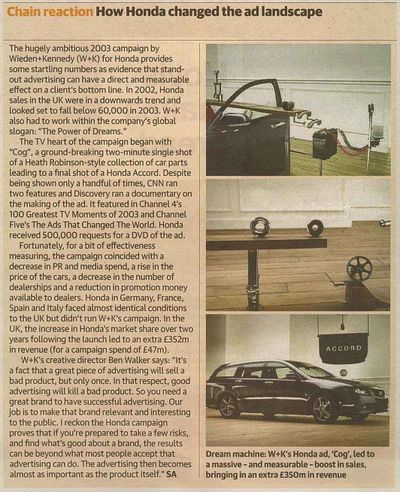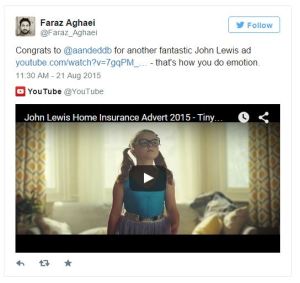Ad of the Week: Guinness Rugby
I think everyone is aware of the Rugby World Cup in England. The games so far have created emotions of defying expectations for the Japanese, shock for the Springboks, delight for the Maori’s and unbridled disappointment from the English having squandered a 7 point lead to lose by 3 points in the dying minutes of Saturday’s game. The look on my friends face when he realised that both Leicester and England lost their matches made me feel a little sympathetic towards him. Today’s post centres around a set of adverts that many people will have been exposed to, either through social media platforms or right before rugby coverage on ITV. It showcases the importance of brand affinity through its connection to sport and most importantly, sells a product through emotive advertising.
Guinness Rugby: AMV BBDO
A few months ago I wrote a post on the history of Guinness advertising. Going back to the early 20th Century, you could see the transformation of the brand from using the tagline: ‘Guinness is good for you,’ right through to the 1970s-80s adverts which showed an old pub with its old regulars. It was at the time of the new millenium when AMV BBDO in London gave Guinness a completely new makeover in their branding strategy which consisted of what is probably known as one of the best pieces of advertising to ever grace the world: “The Surfer.”
From that moment on, a new audience was targeted. A younger, much vibrant audience to that of the 1970s and 80s who were more aware that Guinness was at the bar. With this foundation set in place, now it was time to expand the brand further. One of the best ways to gather awareness is through sports advertising. Marlboro used it extremely effectively throughout the 1970s, 80s and 90s by linking their brand with the successes of the McClaren and Ferrari teams and by sponsoring a wide variety of sports such as snooker, cricket and of course formula one. The same can be said of a number of brands such as Johnnie Walker, Fosters and even blue chip companies (Deloitte sponsor a number of Cricket venues in the UK for example). The one that Guinness has a closer affinity to with regard to sport is Rugby. Guinness is an Irish brand, Rugby is if I remember one of their national sports in conjunction with hurling and gaelic football, it would be silly not to focus your branding on it. As shown below, this was one of the first Guinness adverts to link Guinness to Rugby, and as you can see, it links well the history of the six nations with medievil connotations of war in a light sided way. By making the flag the embodiment of the rugby ball, you can clearly see how AMV BBDO has tried to unleash the emotive side to what is an effective campaign through the tagline: ‘Made of More.’
Emotive Storytelling
I have stated a number of times that the idea of a ‘Big Idea’ is one that sends an emotion to you that you never felt. For someone who was both a bit useless until year 10 of school and not fully understanding the rules of rugby (albeit I did go to a school where Rugby was a top priority), watching these adverts gave me a feeling that I never had. I wanted to learn more about Rugby, and that information was supplied to by Guinness. From then on I instantly recognised Guinness with Rugby, and this can hark back to last year.
In each of the three cases above, these three films look to the inner qualities like humility, dedication and self-belief. The ad campaign for Guinness celebrates the triumph of these qualities, which have helped each hero leave a lasting mark on the game. The case of the Welsh International Shane Williams it was down to Mind over Matter. Being told that he was too small for Rugby could have led him to give up his dream gives a fitting example of being ‘Made of More.’ The hero of 2003 Jonny Wilkinson focuses on the dedication and relentless resolve to bounce back from a number of injuries leading to him being loved by the English and adored by the French. And finally Bill McClaren, the so called ‘voice of rugby’ shows that it is not the misfortune that we are dealt, but how we face it that really counts. These emotive stories tied in with the Guinness Brand shows the affinity of the brand to the sport in a beautiful way.
As the father of advertising David Ogilvy said: ‘if you create a great idea, keep using it until it stops selling.’ Guinness have continued this formula due to 3 important reasons. Having tweeted a number of times to Dave Trott and watched a videos I can clearly see why. It is down to the Impact, Communication and Persuasion:
![]()
It impacts the audience by grabbing their attention. It is able to communicate its message in a way that is understandable to both avid rugby fans and people who aren’t really interested in the sport and is able to persuade its audience. What I mean by persuade is through sub-text; when someone thinks of Guinness, they’d remember the adverts, they remember the emotions behind the heroes.
Which brings me on to my Ad of the Week:
In the case of Gareth Thomas, the former Wales Captain discusses his struggle with regard to hiding his sexuality and how he was able to open up thanks to the help of his team-mates. In the first advert above he says something rather poignant: ‘I went into battle on the pitch every week, but the battle I was going through personally was ten times worse because I was keeping a secret from the team.’ It is understandable having read the tragic story of footballer Justin Fashanu, whereby his conversation with his former manager Brian Clough consisted of the following:
“‘Where do you go if you want a loaf of bread?’ I asked him. ‘A baker’s, I suppose.’ ‘Where do you go if you want a leg of lamb?’ ‘A butcher’s.’ ‘So why do you keep going to that bloody poofs’ club?”
In the case of Gareth Thomas, opening up to his teammates showed a complete opposite of what Fashanu endured. He was supported by his teammates and showed that his sexuality didn’t matter to them at all.
The second advert titled ‘The Right Path’ tells the story of Ashwin Willemse of how he fell in with the wrong crowd and how he was able to turn his life around through the sport of rugby.
Concluding Remarks
These adverts are the reason why they have been chosen as the ad of the week as they show the values of integrity and character that are core to the Guinness brand and to the sport of Rugby. By showing empathy to both these heroes showcases stories that are proud to be celebrated and are truly envisioned within the Guinness Rugby brand of being ‘Made of More.’ As I continue to say, Guinness and AMV BBDO have created a strong formula for future advertising which will continue reap rewards to both the client and the agency. I hope one day I can be able to work on the Guinness account and come up with ideas that can truly ground-breaking and iconic.








